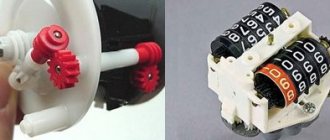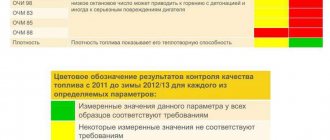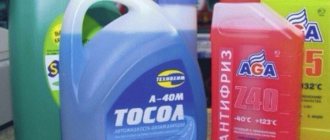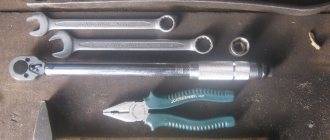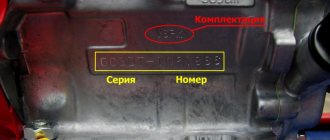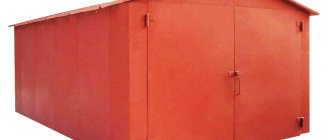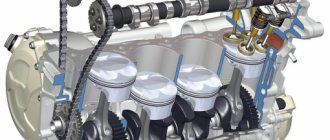Car enthusiasts are often interested in what mileage is considered normal for a used car. This usually happens before purchasing a used car. It is difficult to answer this question, since experts believe that mileage does not always indicate the condition of the car. But this is exactly what the secondary market is trying to manipulate. You should understand that in order to avoid getting into trouble by buying a used car, you need to understand a little about this topic, so before the transaction you should carefully read its important nuances.
How to determine the normal mileage for a used car.
How to determine the real mileage of a car
Experts cannot say exactly what mileage is acceptable for a used car. According to them, this concept is vague, but they urge adherence to the following figures. Thus, the average mileage of a car per year is considered the norm - 20-30 thousand km, provided that the car was constantly in use. If the car is rarely used, the driver can only drive up to 5 thousand km. First of all, to determine the actual mileage, you should study the odometer reading and divide it by the age of the car. Note! This device should also be checked for interference, since many unscrupulous sellers change the numbers on the odometer to increase the cost of the car. On a mechanical device, this is indicated by the condition of the speedometer drive cable. It should not show signs of recent dismantling. Fraud can also be determined by the numbers on the odometer - they cannot be displayed in one strip. To find out if there is fraud on the electronic odometer, you need to make an effort. The fact is that this cannot be determined externally; you will have to contact a service center, where the check is carried out using a special device. The condition of the interior will also help determine the high mileage, regardless of the numbers on the odometer. Usually, if a car is after an accident, its body is repainted so that it looks attractive on the outside, and minimal attention is paid to the interior. Here you can notice:
- A heavily worn seat indicates a mileage of more than 100 thousand km;
- Presence of chips, scratches on the windshield;
- The timing belt is worn or replaced with a new one.
A high mileage is also indicated by the black or bluish color of the exhaust gas. This indicates problems with the engine. The protector will also help in this matter, but often for a successful sale, car owners replace them with new ones.
Potential resource of 1.6-liter power units
The line of power units of the model throughout its existence has been represented by two varieties - F16D3 and F16D4. The car was completed first from the moment of its appearance in Europe until 2015. The station wagon model was equipped with a different 1.6-liter engine – the F16D4. It was combined only with a manual transmission, when the F16D3 worked together with both an automatic and a manual. The engine has less power - 124 horsepower versus 140 horsepower. Next, we will consider in detail what the service life of the Chevrolet Cruze 1.6 engine is.
F16D3
The F16D3 engine first became known in 2002. Then GM engineers assembled a new engine on an old block from F14D3, F18D3. In terms of layout and design, it was actually an exact copy of Opel’s Z16XE engine, which was well known in the “zeros”. But already the F16D3 turned out to be more modern and advanced (it contains an EGR exhaust gas recirculation system valve). It is quite natural that over time the engine begins to annoy the car owner. The valve gets stuck in the open/closed position from time to time due to low-quality fuel. In all other respects, the F16D3 exactly repeats the F14D3, that is, it has adopted the problem areas and “illnesses” of its predecessor. Among the weak points are the valve cover gasket of insufficient quality (it leaks early), the thermostat fails prematurely and carbon deposits actively form on the valves.
The F16D3 engine is based on the cylinder block and head from the F14D3, without serious processing and modernization, except for the cylinders bored to a larger diameter and an increased piston stroke. All developments and technologies that were used in the F14D3 migrated to the F16D3. It turns out that there is no point in chipping it: an increase of 5-10 horsepower will turn out to be insignificant and will just turn into a waste of money. However, there are craftsmen who install a sports camshaft on the F16D3, and bore the F16D3 to 1.8 liters by increasing the cylinder diameter by 1.5 mm and installing the appropriate connecting rods with pistons. As for the probable resource, it is worth relying on the figure of 320,000 kilometers; it is possible to produce 350,000 kilometers, but competent and high-quality care is needed. The main thing in extending the life of the engine is maintenance and more maintenance.
F16D4
The logical continuation of the F16D3 was the brand new F16D4 engine, but in fact this engine is an exact copy of the A16XER, which was equipped with many Opel cars (the engines are identical in all operating parameters and characteristics). The layout is the most common - an in-line “four” with two camshafts. The engine received a variable valve timing system on two shafts. Problems with solenoid valves can begin after 150-200 thousand kilometers. You can determine the breakdown by the operation of the unit: it begins to make noise like a diesel engine, the speed drops and the traction fails. But unlike the F16D3, it does not have an EGR valve. The timing drive is a belt with a service life of 150 thousand kilometers. There are no hydraulic compensators; thermal clearances are adjusted using calibrated glasses (once every 100 thousand km).
The oil leak from under the valve cover gasket has not disappeared, the problems remain essentially the same
When owning a Chevrolet Cruze 1.6 with an F16D4 engine, first of all pay attention to the quality of service. The lubricant (4.5 liters) should be completely changed every 8-10 thousand
km run. The belt is not as sensitive as on the F16D3, but it has been known to break. At the first signs of stretching or mechanical damage, replace it with the original copy. Replacing the belt must be accompanied by the installation of new rollers. After 50 thousand km, the air filter should be changed, and it would not be superfluous to replace the cabin filter. The engine complies with Euro-5 standards and is generally less capricious than its predecessor. Car owners do not often complain about unstable idle speeds and a decline in dynamic performance. As for the probable resource, 350 thousand km is a very realistic figure for this engine.
Does the condition of the car depend only on the mileage?
The mileage of the car does not greatly affect the condition of the vehicle. Any expert can confirm this. The fact is that each individual case has its own nuances. For example, a car has minimal mileage, but its condition leaves much to be desired. The reason for this may be a careless driving style or operating conditions. In turn, cars with high mileage can also be found in good condition, since the driver approached servicing responsibly and promptly changed worn-out parts. Therefore, an excellent solution when buying a used car would be to have it checked by experts at a service station.
New Chinese or old German
Cars made in China, like any Chinese thing, are designed strictly for the warranty period. There are entire scientific laboratories dedicated to ensuring that the car begins to crumble exactly after the specified period. First the electronics will fall off, then the body and chassis. So a “Chinese” with mileage is a chronic patient in the terminal stage.
The complete opposite is a car made in Germany. Legends not only circulate about German quality, but are also confirmed in practice. As a rule, the Germans begin to get rid of their cars after the first 100 thousand km, and after that the car will last for hundreds more, I guess.
What factors affect car wear and tear?
The condition of the car is determined by the following factors:
- Roads along which you most often had to travel;
- Year of release. It will be cheaper to buy an old car. Sometimes such used cars are found with low mileage;
- Type. For example, a passenger car that moves exclusively around the city can cover up to 30 thousand km on average per year, and an SUV used for trips to the countryside or nature can do no more than 10 thousand km. But if we are talking about a heavy truck that is constantly in operation, the mark is 10 thousand km. it can show after a month of driving;
- Operating conditions;
- Driving style, level of care.
Chart of the day: how many kilometers do cars travel before a fatal accident?
Which cars are eligible for the family car program?
The average safe mileage, that is, the number of kilometers that the country's passenger car fleet needs to travel before one fatal accident, in Russia in 2010 was 20.4 million km (there are no more recent data). This is the assessment of Timur Fattakhov from the Institute of Demography of the Higher School of Economics. For comparison, the same mortality rate in road accidents was typical for European countries in the early 1970s. In 2010, the mortality rate in Iceland was 0.26 people per 100 million km (that is, the “safe mileage” was 380 million km), while in Russia the death rate was 4.9 per 100 million km—19 times higher.
“Safe mileage”
,
million km
How many fatal accidents does the entire passenger car fleet of the country travel from one to another on average per year?
The average “safe mileage” is calculated as follows: the number of cars in the country is taken (in Russia – about 40 million), multiplied by the average annual mileage (Fattakhov took 15 thousand km for Russia, because there is no accurate data on the Russian Federation in the international database International Road Traffic and Accident Database, this is close to Avtostat estimates) and is divided by the number of fatal accidents per year.
But is it worth looking for someone to blame, citing the Russian character or bad roads? Fattakhov provides data on how the “safe mileage” changed depending on motorization.
What roads was the used car driven on?
When choosing a car, it is very important to pay attention not only to the mileage of a used car, but also to the condition of the roads along which it was driven. A car that has been driven abroad, even with high mileage, will in most cases be in good condition. This is due to the good quality of the roads. It is believed that even 20 thousand km. for each year, cannot adversely affect the vehicle. Such conclusions are not suitable even for relatively new foreign cars that are destined to drive on domestic roads. Here, excellent condition does not promise even a mileage of 2 thousand km. in a year. Therefore, the buyer should be interested in where the car has accumulated its tens of kilometers. So, having heard about the outback of the country, where the quality of the road surface is poor or there is no road surface at all, even 80 thousand km should alert a car enthusiast. mileage
It is important to remember that 10 thousand km flying through Taiga are very different from the same figure in city traffic jams.
Simple example
Let's consider the simplest and most inexpensive option for solving the problem of “how to choose a used car.” You are a pedestrian by nature and spend a lot of time in active recreation associated with walking. The nearest supermarket is right next to your house, and you don’t need to make huge purchases. But you have a suburban area that is located too far from your home. Of course, you can use public transport.
But what to do during harvest? How to bring home the fruits of your seasonal work? Hiring a truck will negate all efforts to minimize costs. It is extremely inconvenient to carry the entire volume in your hands. How to choose the right used car for such purposes?
There is an option to purchase an inexpensive domestic car. It will be operated, as a rule, in the summer. And the main function is a small truck for transporting the harvested crop. Such a car will not be too expensive, but this does not mean that its choice should be taken lightly.
How to approximately calculate normal mileage when buying a car
Useful expert advice will help you choose a good used car wisely:
- If the car does not look very good in appearance, and its odometer shows a figure of 40 thousand km, you need to ask its owner about this point;
- It is important to find out what type of activity the owner of the car has. For example, if he worked in a taxi, then a mileage of several hundred even for a five-year-old car would be considered the norm. And if the vehicle was used only for trips to buy groceries or to the country, then you shouldn’t be surprised at a mileage of 100 thousand km. with a 10-year vehicle experience (i.e., the average annual mileage of a passenger car is 10 thousand km);
- Before the transaction takes place, you should understand in detail the information about the make of the car and its model. You need to focus on the positive and negative aspects, the manufacturer’s guarantee that the first one fails. Thanks to this information, you will immediately be able to pay attention to important details;
- You should be wary of a car that is too underpriced or overpriced. There is often a twisted run here.
With what mileage is it better to buy a car?
Buying a used car can be called a lottery - you'll be lucky or unlucky. To minimize the unpleasant outcome, you should compare the age of the vehicle and its mileage.
Age no more than 3 years, mileage up to 50 thousand km
Visually, such a vehicle is practically no different from the same one in the showroom. But this is provided that the car was not involved in an accident. Usually the manufacturer's warranty still applies to some components. As for the resource, it has been depleted by 1/3. This indicates the possibility of uninterrupted operation for several more years. Possible risks - incorrect mileage, worn-out backlight parts, nuances with documents, if the car is on loan, pledged, or seized. With this mileage you can buy a good car.
Age 5-7 years, mileage 50-100 thousand km
Outwardly it looks fresh, but traces of use are also present. We are talking about minor damage, scratches on the hood, slightly dimmed headlights, wear on the steering wheel, and pedal pads. You can find cars that still have limited warranties. After purchasing such a car, you will need global maintenance, replacement of belts, filters, fluid, disks, suspension components, and battery. When paying attention to this category of car, it is important to know not only the mileage statistics, the age of the vehicle, but also the thriftiness of the former owner. Good care gives the chance that the car can last for several years without any major vagaries.
Age about 10 years, mileage 100-150 thousand km
This range indicates that the machine is no longer under warranty. The wear of many parts, chips, scratches, small dents is visually visible; there may be faulty electrical equipment, fuel equipment, automatic transmission, or air conditioning system. If the owner has put a high price on it, this does not mean the car is in good condition. When buying a car, it is recommended to undergo diagnostics at a trusted service station. However, you need to understand that not all defects can be found out in this way. Such an acquisition is a risk, so increased care and proper verification are required.


